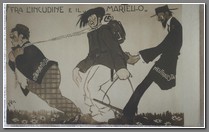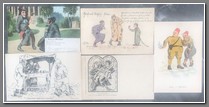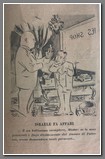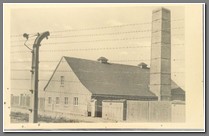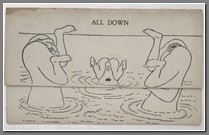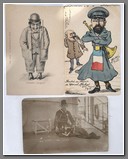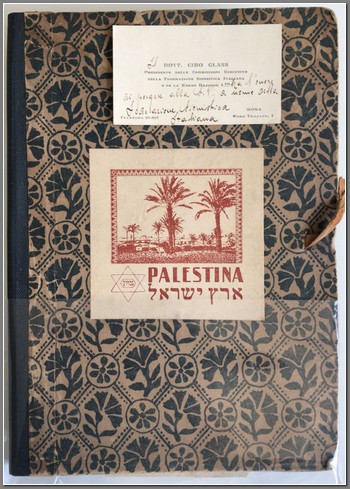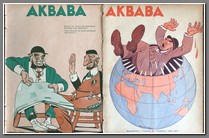Holocaust Studies
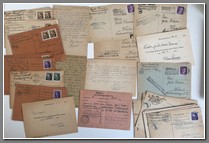 HOL 067Rare collection of 29 short letters from Germans living in the Theresienstadt ghetto/camp to one Grete Breuer who lived at Seitenstelteng 4, Vienna. A total of 16 different people are writing. The postcards are officially imprinted from Theresienstadt and contain the stamp of the German censor who reviewed the correspondence. The surnames of the inmates include Weinstein, Wottiz, Kolmin, Kokesch, Roubicek, Spitzer, Grunfeld, Breuer, Ermes, Bolum, Holser, Weil, Sharer, and more. Some interesting things stand out. For instance, the inmates who sent more than one letter, showed different addresses, indicating that they were moved within the ghetto. Some are stamped Reply only to postcards in German. Others are stamped Answer only to the Reich Association of Jews in Germany (which was set up to help convince German jews to emigrate to Theresienstadt). B
HOL 067Rare collection of 29 short letters from Germans living in the Theresienstadt ghetto/camp to one Grete Breuer who lived at Seitenstelteng 4, Vienna. A total of 16 different people are writing. The postcards are officially imprinted from Theresienstadt and contain the stamp of the German censor who reviewed the correspondence. The surnames of the inmates include Weinstein, Wottiz, Kolmin, Kokesch, Roubicek, Spitzer, Grunfeld, Breuer, Ermes, Bolum, Holser, Weil, Sharer, and more. Some interesting things stand out. For instance, the inmates who sent more than one letter, showed different addresses, indicating that they were moved within the ghetto. Some are stamped Reply only to postcards in German. Others are stamped Answer only to the Reich Association of Jews in Germany (which was set up to help convince German jews to emigrate to Theresienstadt). B
Price: $1500.00
Note: The Germans had a problem with disposing of the 250,000 jews in Germany without raising a public outcry. So they converted Theresienstadt in Bohemia as a “showcase” camp. German jews were told it was a far better place to live than the constant harassment in Germany. The travelled there on passenger trains and were issued first class tickets. They were allowed to take their belongings. When they arrived they could enjoy concerts and outdoor pools. Not long afterwards though they were shipped eastward for extermination. Theresienstadt was the camp the nazis showcased to the Red Cross when they came for inspection.
Note from Wikipedia: Theresienstadt Ghetto was established by the SS during the war in the fortress town of Terezín, in the Protectorate of Bohemia and Moravia (German-occupied Czechoslovakia). It served as a waystation to the extermination camps. Its conditions were deliberately engineered to hasten the death of its prisoners, and the ghetto also served a propaganda role. Unlike other ghettos, the exploitation of forced labor was not economically significant.
In October 1941, as the Reich Security Main Office (RSHA) was planning transports of Jews from Germany, Austria, and the Protectorate to the ghettos in Nazi-occupied Eastern Europe, a meeting was held in which it was decided to convert Theresienstadt into a transit center for Czech Jews. Those present included Adolf Eichmann, leader of the RSHA section IV B 4 (Jewish affairs) and Hans Günther, the director of the Central Office for Jewish Emigration in Prague. Reinhard Heydrich, the RSHA chief, approved of Theresienstadt as a location for the ghetto. At the Wannsee Conference on 20 January 1942, Heydrich announced that Theresienstadt would be used to house Jews over the age of 65 from the Reich, as well as those who had been severely wounded fighting for the Central Powers in World War I or won the Iron Cross 1st Class or a higher decoration during that war. These Jews could not plausibly perform forced labor, and therefore Theresienstadt helped conceal the true nature of deportation to the East. Later, Theresienstadt also came to house "prominent" Jews whose disappearance in an extermination camp could have drawn attention from abroad. To lull victims into a false sense of security, the SS advertised Theresienstadt as a "spa town" where Jews could retire, and encouraged them to sign fraudulent home purchase contracts, pay "deposits" for rent and board, and surrender life insurance policies and other assets
The transportation of Czech Jews began in November 1941. The first German and Austrian Jews arrived in June 1942; Dutch and Danish Jews came at the beginning in 1943, and prisoners of a wide variety of nationalities were sent to Theresienstadt in the last months of the war. About 33,000 people died at Theresienstadt, mostly from malnutrition and disease. More than 88,000 people were held there for months or years before being deported to extermination camps and other killing sites; the role of the Jewish Council (Judenrat) in choosing those to be deported has attracted significant controversy. The total number of survivors was around 23,000, including 4,000 deportees who survived. Theresienstadt was the only Jewish community in Nazi-occupied Europe that was led by Zionists.
Theresienstadt was known for its relatively rich cultural life, including concerts, lectures, and clandestine education for children. The fact that it was governed by a Jewish self-administration as well as the large number of "prominent" Jews imprisoned there facilitated the flourishing of cultural life. This spiritual legacy has attracted the attention of scholars and sparked interest in the ghetto. In the postwar period, a few of the SS perpetrators and Czech guards were put on trial, but the ghetto was generally forgotten by the Soviet authorities. The Terezín Ghetto Museum is visited by 250,000 people each year.
Italian Zionist photo archive of 32/33 captioned photos from 1927. Important data shown under “Some data on Palestinian Reconstruction”, with map showing the areas of Hebrew occupation. This was presented as a gift from Dott. Ciro Glass, President of the Executive Commission of the Italian Zionist Federation and the Keren Haiesod. On the back of the card, it says “as a gift to this we have a photo of the jewish sister Balutina, in the constitution day of the Italian Committee". B
Price: $1500.00
Note: Keren Hayesod was established at the World Zionist Congress in London on July 7–24, 1920 to provide the Zionist movement with resources needed to establish a Jewish homeland in Palestine. It came in response to the Balfour Declaration of 1917, which stated that “his Majesty's government views with favour the establishment in Palestine of a national home for the Jewish people” - turning the ages-old dream of the return to Zion into a politically feasible goal. Keren Hayesod established fundraising organizations around the world. During the 1920s, Keren Hayesod began to lay the groundwork for a Jewish National Home and helped raise funds to establish the Hebrew University of Jerusalem, Bank Hapoalim and various physical projects. In 1926, Keren Hayesod relocated its headquarters from London to Jerusalem.
Two 1936 issues of Akbaba, with antisemitic themes on the covers. One reads: “From the newspapers: There is no rest for the Jews in Palestine”. The other reads: “Salamon b... Arabs were throwing balls. Why don't our people throw it?..No, Mishonaci, is it not the custom of the Jews to throw a ball?”. B
Price: $200.00

